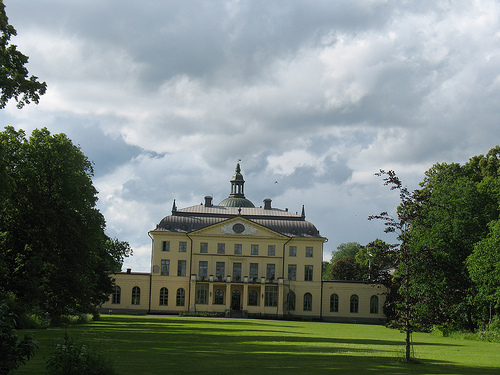

Location: South of Linköping Map
Constructed: 1791-1795, rebuilt in 1894-1898
Bjärka-Säby Castle is a beautiful baroque residence situated near Linkoping in Ostergotland County in Sweden. Despite its military name Bjärka-Säby Castle is not actually a castle. Bjärka-Säby Castle was constructed in 1791 as a private residence for Swedish aristocrat and a diplomat Germund Louis Cederhielm under supervision of an architect Fredik Magnus Piper (1746- 1824).
Later Bjärka-Säby Castle was sold to Consul Oscar Ekman (1812- 1907) in 1872. Original building had a neo- classical architectural style, but in 1894- 98 reconstruction under guidance of Agi Lindegren a more baroque style became evident in the appearance of Bjärka-Säby Castle. Ekman family that owned this residence finally sold their residence to the Zion Church in Linkoping on April 1, 1980 which still owns the residence today.
Bjärka-Säby new castle is a castle building in a flamboyant baroque
style with manor roofs, located in an Östergötland leafy meadow
landscape east of Stora Rängen, 250 meters northeast of the old castle.
The interior, on the other hand, has the character of the late 18th
century.
The castle is owned by Sionförsamlingen in Linköping,
and functions as a course, conference, parish and retreat yard. The
business has a clear ecumenical focus. The Pilgrim Magazine also has its
base in the castle. The castle is available for visits and tours are
arranged. A summer café open to the public is located on the castle's
premises.
n behalf of Germund Ludvig Cederhielm, the architect Fredrik Magnus
Piper (1746–1824) prepared a series of proposals for a man-made building
in neoclassical style in accordance with the client's special wishes.
Construction began in 1791 and was completed shortly before the turn of
the century 1799/1800. The surrounding landscape was transformed into an
English park. When it comes to garden architecture, Piper was the right
man in the right place. He was the foremost garden architect of the
time, better known as such than as a building architect.
In 1872,
the estate was taken over by Consul Oscar Ekman (1812–1907). He and his
son Oscar developed the estate into a model farm. The Ekman family built
a school, a retirement home, a hospital and workers' housing. The
interest in the history of the area was great and much of the older
buildings are preserved today.
A rebuilding took place
in 1894–1898 by the castle architect Agi Lindegren. He then carried out
the high roof erection, which gives the castle a baroque appearance that
differs from Piper's design language and is reminiscent of the Knights'
House in Stockholm. The tower is also a creation of Lindegren. Under the
estate's property were a large number of farms and crofts.
Following a proposal by Professor Sigurd Curman and architect Erik Fant,
a restoration of the interior was carried out in 1920–1921, so that it
again reflects the late 18th century. The exterior, on the other hand,
has been allowed to retain its appearance from Agi Lindgren's
renovation.
The Ekman family donated the castle and the castle
park to Sionförsamlingen in Linköping, which has owned it since 1 April
1980. The castle is the seat of a Christian ecumenical community.
Bjärka-Säby castle chapel
In 1878, a castle chapel was decorated
in the east wing of the New Castle. The rectangular room with cows to
the north was inaugurated as a place of worship in 1884. The chapel is
designed in a simple neoclassical style with large round arched windows
framed with pilasters and a flat ceiling with decorative paintings. The
altarpiece, also between two pilasters, shows Christ as Savior. The
first communion and the crucifixion are illustrated in the ceiling. The
pulpit is to the left of the choir, on the gospel side of the chapel.
Organ
In 1841 there was a pipe organ which in the 1840s was sold
to the Hospital Church in Linköping.
1986: Set-up here of a
mechanical organ work, which was previously owned by Sture Petri. The
instrument consists of older materials. Väderlådan and Flöjt Amabile 8
'come from an organ in Barkeryds kyrka, Småland, built in 1873 by Erik
Nordström. New facade from 1986. The organ was taken over in 2015 by
Endrei Tarnai, organ builder from Budapest.